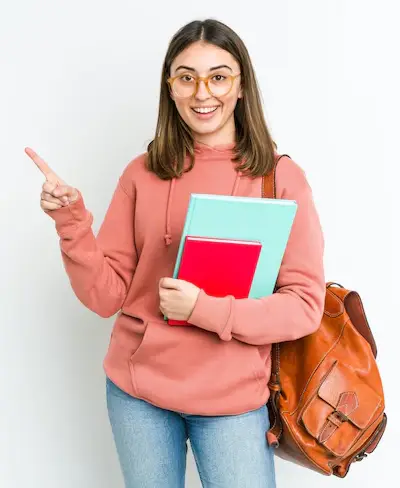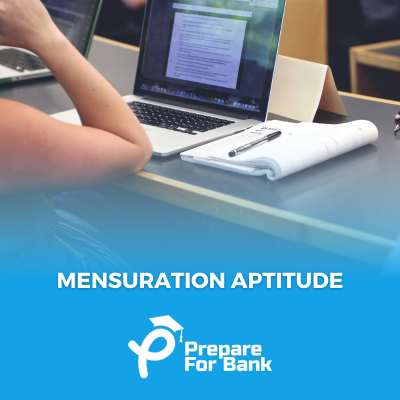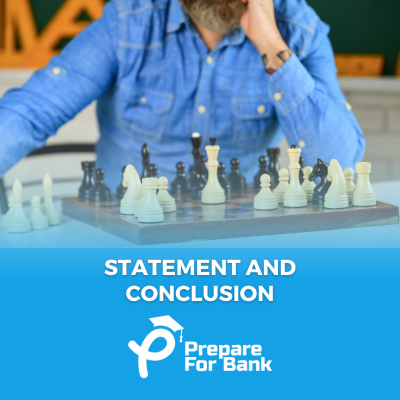Mensuration aptitude is an important topic to be covered in competitive exams preparation be it for IBPS Clerk, PO, RRB, SO, or SBI Clerk or PO. The number of questions and the complexity of questions vary from exam to exam every year.
Mensuration aptitude is complex in nature and requires an understanding of Numbers Systems, Squares and Square roots, Cubes and Cube roots, Percentage Calculation, and Math Tables. Example questions and practice questions on Mensuration are given in this article.
Nowadays, questions in exams are mixed with multiple concepts and it requires practice and a deep understanding of basic concepts along with quickly identifying numbers.
What is Mensuration Aptitude?
Mensuration Aptitude is related to the study of measurement of objects or shapes on different parameters like length, height, surface, area, volume, and size. Measurement of different shapes has different sets of formulas to calculate its various measurements.
Objects are classified on many different parameters but the basic difference for calculation purposes is the dimension of an object. Objects can be classified under two and three-dimension.
Mensuration Dimensions
Mensuration of any objects or shape can be classified in two dimensions that are: 2-D and 3-D. Below are the difference between 2-D and 3-D objects or shapes:
| S.No. | 2 Dimensional | 3 Dimensional |
| 1 | If the shape is drawn on paper or plain ground, having all the points on the same plane. | If the shape is created using craft activity and all points don’t lie on the same plane. |
| 2 | Height or Depth is not present in 2-D shapes or objects. | Height or Depth is present in 3-D shapes or objects |
| 3 | Only 2 Dimensions are present. Such as Length and Breadth. | Only 3 Dimensions are present. Height, Length and Breadth. |
| 4 | Mensuration can be of Area and Perimeter. | Mensuration can be of Volume Surface Area such as Curved, Lateral, and Total. |
Mensuration Terms
Below are the mensuration terms and their definition in which an object or shape can be measured:
| S.No. | Term | Abbreviation | Definition |
| 1 | Area | A | 2-D Unit Surface closed in a given shape. Unit of measurement: M2 or Cm2 |
| 2 | Perimeter | P | 2-D Measure of the boundaries which is enclosed by the shape. Unit of measurement: M or cm |
| 3 | Volume | V | 3-D Measure of gas or liquid can be contained inside an object. Unit of measurement: M3 or Cm3 |
| 4 | Curved Surface Area | CSA | If the 3-D object is having a curved surface such as cone. Then the total area of that Curved Surface. Unit of measurement: M2 or Cm2 |
| 5 | Lateral Surface Area | LSA | If the 3-D object is having a lateral surface. Then the total area of that Lateral Surface. Unit of measurement: M2 or Cm2 |
| 6 | Total Surface Area | TSA | For 3-D objects, the sum of all the Surface Area is known as the Total Surface Area (TSA). Unit of measurement: M2 or Cm2 |
Mensuration Aptitude Formulas
2-D Mensuration Formula
Mensuration Aptitude formula of calculating 2-Dimensional objects or shapes. There are frequently used shapes are, Square, Rectangle, Triangle, Circle, and other quadrilateral shapes such as Parallelogram and Trapezium:
| S.No. | Shape | Area Formula | Perimeter Formula |
| 1 | Square | a2 | 4 x a |
| 2 | Rectangle | l x b | 2 x (l + b) |
| 3 | Circle | πr2 | 2πr |
| 4 | Equilateral Triangle | (√3/4) × a2 | 3 a |
| 5 | Isosceles Triangle | ½ × b × h | 2 x a + b |
| 6 | Scalene Triangle | √[s(s−a)(s−b)(s−c)], Where, s = (a+b+c)/2 |
(a+b+c) |
| 7 | Parallelogram | l x b | 2 x (l = b) |
| 8 | Trapezium | ½ h(a+b) | a + b +c + d |
3-D Mensuration Formulas
Mensuration Aptitude formula of calculating 3-Dimensional objects or shapes. There are frequently used shapes are, Cube, Cuboid, Cone, Cylinder, and Sphere:
| S.No. | Shape | Volume | Surface Area |
| 1 | Cube | a3 | TSA = 6 a2 |
| 2 | Cuboid | l × b × h | TSA = 2 (lb +bh +hl) |
| 3 | Sphere | (4/3) π r3 | TSA or CSA = 4 π r2 |
| 4 | Hemisphere | (⅔) π r3 | TSA = 3 π r 2 CSA = 2 π r 2 |
| 5 | Cylinder | π r 2 h | TSA = 2πrh + 2πr2 CSA = 2π r h |
| 6 | Cone | (⅓) π r2 h | TSA = πr (r + l) CSA = πrl |
Solved Examples of Mensuration Aptitude
Below are a few solved examples on Mensuration Aptitude:
Example 1: Calculate the Area and Perimeter of Square land which is having all sides of the same length of 10 meters.
Solution 1: From the above-given formula we can calculate the area and perimeter of the square as:
=> Given the length of one side a = 10 meters.
=> Area of Square = a2 = 102 = 100 square meters.
=> Perimeter of Square = 4a = 10 x 4 = 40 meters.
Example 2: A piece of land whose one side is 15 meters and the other side is 10 meters. Find the total expenditure on fencing if charges are 6/- rs per meter.
Solution 2: From the above question it’s clear that piece of land is rectangle. Fencing will only require the perimeter to be calculated for the piece of land.
=> Perimeter of Land = 2 x (l + b) = 2 x (15 + 10) = 2 x 25 = 50 Meters.
=> Total charge of fencing = 6 x 50 = 300 Rs.
Example 3: Find the area and circumference of the Circle if the radius of the circle is 14 cms.
Solution 3: From the above-given formula we can calculate the area and circumference of a circle as:
=> Given radius of circle r = 14 cms.
=> Area of Circle = πr2 = (22 x 142) / 7 = (22 x 196) / 7 = 4312 / 7
=> 616 square cms.
=> Circumference of circle = 2πr = 2 x 22 / 7 x 14 = 44 x 2 = 88 cms.
Example 4: Find the Total Surface Area (TSA) and Volume of Cube who any given side is of 10 cms.
Solution 4: From the above-given formula we can calculate the total surface area and volume of the cube as:
=> Given the length of any side a = 10 cms.
=> Total Surface Area of Cube (TSA) = 6a2 = 6 x 102 = 6 x 100
=> 600 square cms.
=> Volume of Cube = a3 = 103 = 1000 cube cms.
Example 5: Find the Volume and Total Surface Area of Sphere where the radius is 14 cms.
Solution 5: From the above-given formula we can calculate the total surface area and volume of the sphere as:
=> Given radius of sphere r = 14 cms.
=> Total Surface Area of Sphere (TSA) = 4 π r2 = 4 x 22/7 x 142 = 88 / 7 x 196
=> 88 x 28 = 2464 square cms.
=> Volume of Sphere = (4/3) π r3 = (4/3) x (22/7) x143 = 1498.6 cube cms.
Practice Questions on Mensuration Aptitude
Below are a few practice questions on Mensuration Aptitude:
- Find the area and perimeter of a square whose side is 15 cms?
- A rectangle whose length and breadth are in the ratio of 2:3. If length is 15 cms, then find area and perimeter?
- An equilateral triangle having a length of any side as 50 cms then find area and perimeter?
- Find the area and perimeter of Parallelogram whose length is 30 cms and breadth is 20 cms?
- Find the area of the circle whose radius is 35 cms?
- Find the volume and total surface area of the Sphere, where the radius is 7 cms?
- Find the area of Cube and Total Surface area of Cube where any given side is 15 cms?
- A Cuboid whose length and breadth are in the ratio of 2:3. If the length is 12 cms, then find the volume and Total surface area?
- A Cylinder whose radius and height are in the ratio of 2:5. If the radius is 14 cms, then find the volume and total surface area?
- A Cone whose radius and height are 14 cms and 21 cms respectively, then find the volume and total surface area?
Final Words
Practicing the above questions for Mensuration Aptitude is not the end of your practice, but it’s the start of a new journey to apply logic on Mensuration Aptitude with multiple approaches in a right and faster way.
For cracking competitive exams one must practice Mensuration Aptitude without a calculator is a must. At last, during the exam, if a solution for the Mensuration Aptitude questions cannot be found easily then mark that question to revisit and move ahead instead of wasting time and energy.
Courses you might be interested in
-
0 Lessons







